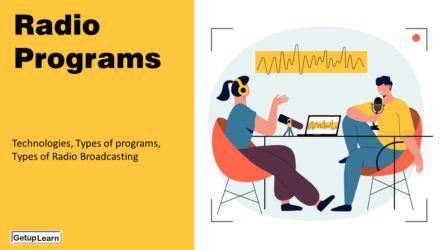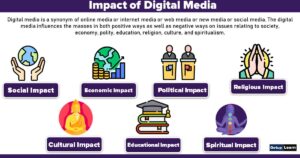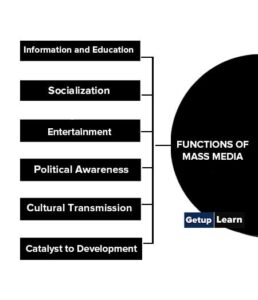Table of Contents
- 1 What is the Role of Media?
- 2 Types of Media Organisations
-
3 Print Media Organisations
- 3.1 Registrar of Newspapers for India
- 3.2 The Press Information Bureau (PIB)
- 3.3 Publications Division
- 3.4 Press Council of India (PCI)
- 3.5 Directorate of Advertising and Visual Publicity (DAVP)
- 3.6 Audit Bureau of Circulations (ABC)
- 3.7 Indian Newspaper Society (INS)
- 3.8 National Readership Survey (NRS)
- 3.9 Indian Readership Survey (IRS)
- 3.10 Readership Studies Council of India (RSCI)
- 4 Electronic Media Organisations
-
5 Film Organisations
- 5.1 Films Division
- 5.2 National Film Development Corporation Limited (NFDC)
- 5.3 Central Board of Film Certification (CBFC)
- 5.4 Children’s Film Society, India (CFSI)
- 5.5 National Film Archives of India (NFAI)
- 5.6 Directorate of Film Festivals
- 5.7 Kerala State Film Development Corporation
- 5.8 Kerala State Chalachitra Academy
- 6 Media Training Institutes
- 7 Media Apex Authorities
- 8 FAQs About Media Organisations in India
What is the Role of Media?
Media play a crucial role in our daily life. The most influential media decide our taste and the way of life. The media include newspapers, magazines and books, radio and television and the world wide web. They are considered to be the fourth pillar of democracy. To support the activities of these media and to monitor them there are several organizations.
Table of Contents
Most of them come under the Union Ministry of Information and Broadcasting. Such media organizations are not much familiar to the public. But their roles are very important in the functioning of the Fourth Estate.
We know that the nature and treatment of media contents, to a large extent, are influenced by media ownership. We shall discuss media organizations that come under the purview of the Government of India. We shall look at the organizational structure and management of these government media organizations.
After reading this article you should be able to:
- Identify and list the various government media organizations.
- Relate them to their specific, areas of work; describe the organizational network of individual government media organizations.
- Illustrate, by quoting instances, the role of different government media departments when organising or providing publicity to any event or national interest.
Types of Media Organisations
Let us scan through some of the types of media organisations that have prime importance;
- Print Media Organisations
- Electronic Media Organisations
- Film Organisations
- Media Training Institutes
- Media Apex Authorities
Print Media Organisations
print media have a long year’s history in the media scene of India. From Hicky’s Gazette to modern hi-tech media environment, our media organizations passed through various phases. To support and organize activities of the print media in a systematic way there are some media organizations established by the government and non-government agencies.
Most of such organizations are based on the Acts of Parliament and they issue guidelines for the systematic functioning of the print media sector:
- Registrar of Newspapers for India
- The Press Information Bureau (PIB)
- Publications Division
- Press Council of India (PCI)
- Directorate of Advertising and Visual Publicity (DAVP)
- Audit Bureau of Circulations (ABC)
- Indian Newspaper Society (INS)
- National Readership Survey (NRS)
- Indian Readership Survey (IRS)
- Readership Studies Council of India (RSCI)
Registrar of Newspapers for India
The office of the Registrar of Newspapers for India, more popularly known as RNI, came into being on July 1, 1956. The RNI is established on the recommendations of the First Press Commission in 1953. The Press and Registration of Books (PRB) Act, 1867 contain the duties and functions of the RNI.
It is compulsory to register all printed materials to the RNI. As per Rule 5 of PRB Act, 1867, no newspaper shall be published in India without formal registration. A newspaper means “any printed periodical work containing public news or comments on public news”.
Hence, any publication coming under this category of newspaper is required to be registered with RNI.
Major functions of RNI are:
- Title verification.
- Registration of newspapers.
- Issue of revised/duplicate certificates.
- Verification of circulation claims of newspapers and periodicals.
The Press Information Bureau (PIB)
The Press Information Bureau (PIB) is the nodal agency of the Government of India to disseminate information to the print and electronic media on government policies, programs, initiatives, and achievements. It functions as an interface between the Government and the media.
Activities of PIB can be broadly classified into three categories:
- Information, education & communication (publicity)
- Feedback to the Government
- Accreditation and Special Services
Publications Division
The Publications Division of the Government of India aims at providing authentic information on different aspects of Indian panorama at affordable prices. It was established in 1941.
Books of Publications Division cover a wide range of subjects including art, culture, history, land and people, flora and fauna, children’s literature, science and technology, Gandhian literature and biographies of eminent persons.
The reference materials like India-A Reference Annual, Press in India and MassMedia in India are valuable contributions of this division. The Division also brings out 18 monthly journals in several Indian languages including Malayalam. ‘Employment News’ is their popular weekly.
Press Council of India (PCI)
Press Council of India is a statutory quasi-judicial authority mandated by the Parliament to preserve the freedom of the press, maintain and improve the standards of newspapers and the news agencies in India.
The Council discharges its functions primarily through adjudications on complaints received either against the Press for violation of journalistic ethics or by the Press for interference with its freedom.
If a newspaper or a news agency has violated the ethics of journalism or that an editor or working journalist has committed any professional misconduct, the Council may warn, admonish or censure them or disapprove their conduct.
The Council is also empowered to make such observations as it may think in respect of the conduct of any authority, including Government, for interfering with the freedom of the press. The decisions of the Council are final and cannot be questioned in any court of law.
Directorate of Advertising and Visual Publicity (DAVP)
The directorate of Advertising and Visual Publicity (DAVP) is the primary multimedia advertising agency of the Central Government. It caters to the communication needs of almost all Central ministries/ departments and autonomous bodies.
Providing single-window cost-effective services is its uniqueness. It informs and educates the people, both rural and urban, about the Government’s policies and programmes. It motivates them to participate in development activities through advertising in the press, electronic media, printed booklets/ folders, exhibitions and outdoor publicity tools.
Outdoor Publicity Wing uses the medium of hoardings, bus panels, kiosks, wall paintings, banners, animation displays, decorative railings, cinema slides, metro display boards, metro train inside panels, etc. to spread messages.
Audit Bureau of Circulations (ABC)
Audit Bureau of Circulations (ABC) is a voluntary organization of publishers, advertisement agencies and advertisers. This agency developed audit procedures to verify the circulation data published by the member newspapers and periodicals.
These members are allowed to display ABC’s emblem in the published materials regarding their circulation. The Bureau issues ABC certificates every six months to the publishers. The ABC’s certificate is considered to be authentic in publication’s circulation ratings.
The reason is that the ABC’s findings are not the outcome of opinions, claims or guesswork. They are the result of rigid, in-depth and impartial audits of paid circulations of the member publications. So the advertisers rely upon the figures to decide which publication is suitable to advertise their product or services.
Indian Newspaper Society (INS)
Indian Newspaper Society (INS) was formerly known as Indian and Eastern Newspaper Society (IENS). It is an independent organization of newspaper owners, proprietors and publishers. It was founded in 1939 and its headquarters is situated in New Delhi.
INS is an organization which plays a major role in protecting and promoting the freedom of the press in India. It discusses and suggests various measures to the government regarding the problems related to newspaper industry.
It also functions as a pressure group to protect the interests of newspaper industry in particular and print media in general.
National Readership Survey (NRS)
The National Readership Survey (NRS) was first started in 1974. It was done by National Readership Studies Council (NRSC) – jointly formed by the Advertising Agencies’ Association of India, the Indian Newspaper Society and the Audit Bureau of Circulations.
The primary objective of National Readership Survey is to provide data that can be used as a basis for buying and selling of advertising space in the print medium.
Indian Readership Survey (IRS)
The Indian Readership Survey (IRS) was initiated to counter the NRS, which was supported by large newspaper groups. It was conducted by the Media Research User’s Council (MRCU) and the first IRS was carried out in 1995. It offers the readership and market study to its members.
Readership Studies Council of India (RSCI)
The National Readership Survey (NRS) and the Indian Readership Survey (IRS) have merged to form a new entity – Readership Studies Council of India (RSCI).
Electronic Media Organisations
Media platforms and devices are changing almost every month and the convergence of the media overcomes the boundaries which separated interpersonal communication from mass communication.
New media have brought forth new means of individual empowerment, allowing the expression of individual ideas, opinions and identities.
Hence the focus has been shifted to the regulation of the electronic media by the various media organisations, individually or collectively:
- Prasar Bharati
- Parliament Channels
- Indian Broadcasting Foundation (IBF)
- Broadcasting Content Complaints Council (BCCC)
Prasar Bharati
Prasar Bharati (Broadcasting Corporation of India) is the Public Service Broadcaster in the country. It is a statutory autonomous body established on November 23, 1997, with a mandate to organize and conduct public broadcasting services to inform, educate and entertain the public and to ensure a balanced development of broadcasting on radio and television.
Akashvani (All India Radio) and Doordarshan are its two constituents.
The major objectives of the Prasar Bharati Corporation as laid out in the Prasar Bharati Act 1990 is as follows:
- To uphold the unity and integrity of the country and the values enshrined in the Constitution.
- To promote national integration.
- To safeguard citizen’s rights to be informed on all matters of public interest and presenting a fair and balanced flow of information.
- To pay special attention to the fields of education and the spread of literacy, agriculture, rural development, environment, health and family welfare and science and technology.
- To create awareness about women’s issues and taking special steps to protect the interests of children, aged and other vulnerable sections of the society.
- To provide adequate coverage to the diverse cultures, sports and games and youth affairs.
- To promote social justice, safeguarding the rights of working classes, minorities and tribal communities.
- To promote research and expand broadcasting facilities and development in broadcast technology.
All India Radio
All India Radio or Akashvani is a part of Prasar Bharati. It provides radio broadcasting through out the country and abroad. It is one of the largest broadcasting organisations in the world in terms of the number of languages and the spectrum of socio-economic and cultural diversity it serves.
Its motto is ‘Bahujana Hitaya Bahujana Sukhaya’ which means ‘the welfare and happiness of the masses’.
Doordarshan
Doordarshan is one of the main organs of Prasar Bharati. It provides television services in the country. Its motto is ‘Satyam Shivam Sundaram’, which can be translated as ‘the truth is the God and the God is beautiful’. The television transmission started in India on an experimental basis on 1st November 1959 at New Delhi.
At first the TV programmes were produced and transmitted by AIR and were available for half an hour in three days a week. Doordarshan started colour transmission. Today it operates 30 TV channels in 22 languages.
Parliament Channels
The Parliament channels include Rajya Sabha Television and Lok Sabha Television:
Rajya Sabha Television (RSTV)
The Rajya SabhaTelevision telecast the proceedings of the Upper House of Parliament in India, i.e. Rajya Sabha. It provides a live coverage of the functioning of the Rajya Sabha. RSTV also telecast programmes that touch the political, economic, social and cultural life of the people.
Lok Sabha Television (LSTV)
The Lok Sabha Television is a parliament channel dedicated to the live telecasting of the proceedings of Lok Sabha i.e, the House of the People of the Indian Parliament. The channel also telecasts programmes of general interest on the issues relating to democracy, governance, social, economic and constitutional issues that concern the citizens.
Indian Broadcasting Foundation (IBF)
The Indian Broadcasting Foundation (IBF) was established in 1999 and is India’s apex organization of television broadcasters. It promotes the interests of the Indian television industry and provides a meeting ground to ensure that its members work in consensus to achieve common goals.
IBF consists of all major broadcasters from more than 250 TV channels.
Broadcasting Content Complaints Council (BCCC)
Broadcasting Content Complaints Council (BCCC) is an independent self-regulatory body for non-news channels set up in June 2011 by the Indian Broadcasting Foundation (IBF) in consultation with the Ministry of Information and Broadcasting.
The council comprises of a thirteen-member body consisting of chairperson being a retired Judge of the Supreme Court or High Court and 12 other members. BCCC would examine complaints about television programmes received from viewers or any other sources.
Film Organisations
The focus of the various film organizations in India is to screen films of merit and excellence in the commercial circuit. Festivals and retrospectives focusing on the work of well-known directors and actors are also arranged by these organisations.
Over the years, they also have created a space for documentary filmmakers to present their films. Reflecting the changing patterns in the acceptance and use of film as a tool of debate and contestation, these organizations bring focus on current issues of society, politics, economics, ecology and conservation policies and practices.
These are film organization which given below:
- Films Division
- National Film Development Corporation Limited (NFDC)
- Central Board of Film Certification (CBFC)
- Children’s Film Society, India (CFSI)
- National Film Archives of India (NFAI)
- Directorate of Film Festivals
- Kerala State Film Development Corporation
- Kerala State Chalachitra Academy
Films Division
Films Division, one of the units under Union Ministry of Information and Broadcasting produces documentaries, short films, animation films and news magazines from its headquarters in Mumbai. Films on Defence and family welfare are produced from the Delhi unit.
Short fiction films for the rural audiences are produced from the regional production centers in Kolkata and Bengaluru. The Division caters to nearly 8500 cinema theatres all over the country and to the non-theatrical circuits.
This Division also sells prints, stock shots, video cassettes and distribution rights of documentaries and feature films in India and abroad.
National Film Development Corporation Limited (NFDC)
National Film Development Corporation of India is the central agency established to encourage the good cinema movement in the country. The primary goal of the NFDC is to plan, promote and organize an integrated and efficient development of the Indian film industry.
NFDC encourages new talents and to promote the multi-lingual diversity of Indian cinema. It produces entirely the first feature film of a Director to be made in any Indian language, subject to budgetary cap under this scheme.
NFDC has set up a trust in 1992 known as Cine Artist’s Welfare Fund of India (CAWFI) which extends financial assistance to the needy cine artists of yesteryears. This is the biggest ever trust of this kind in the Indian film industry.
Central Board of Film Certification (CBFC)
The Central Board of Film Certification (CBFC), set up under the Cinematograph Act, 1952, certifies films for public exhibition in India. It is mandatory for public screening and to display it before screening in movie houses and TV.
It consists of a Chairperson and twenty- five other non-official members. The Board has its headquarters at Mumbai and nine regional offices located at 125 Bengaluru, Kolkata, Chennai, Cuttack, Guwahati, Hyderabad, Mumbai, New Delhi and Thiruvananthapuram.
The regional offices are assisted in the examination of films by the advisory panels consisting of persons from the different walks of life.
Categories of Film Certification
| Certificate | Name | Definition/Notes |
| U | Universal | Unrestricted Public Exhibition throughout India, suitable for all age groups. Films under this category should not upset children over 4 years. Such films may contain educational, social or family-oriented themes. Films under this category may also contain fantasy violence and/or mild bad language. |
| UA | Parental Guidance | All ages admitted, but it is advised that children below 12 years be accompanied by a parent as the theme or content may be considered intense or inappropriate for young children. Films under this category may contain mature themes, sexual references, mild sex scenes, violence with brief gory images and/or infrequent use of crude language. |
| A | Adults Only | Restricted to adult audiences (18 years or over). Nobody below the age of 18 may buy/rent an A-rated DVD, VHS, UMD or watch a film in the cinema with this rating. Films under this category may contain adult/disturbing themes, frequent crude language, brutal violence with blood and gore, strong sex scenes and/or scenes of drug abuse which is considered unsuitable for minors. |
| S | Restricted to any special class of persons | This rating signifies that the film is meant for a specialised audience, such as doctors. |
Children’s Film Society, India (CFSI)
The Children’s Film Society, India (CFSI) formed in 1955 is an autonomous body, functioning under the Union Ministry of Information and Broadcasting. CFSI aims at harnessing the medium of cinema to provide healthy entertainment for children in particular and the youth in general.
CFSI conducts film festivals all over India, reaching 40 lakh children in remote areas annually. The CFSI has three prime objectives viz., production & acquisition of films, distribution and organisation of International Children’s Film Festival.
CFSI is engaged in the production of feature films, featurettes, animation, short films, puppet films and TV serials. The organisation also procures exhibition rights of award winning Indian and foreign films.
National Film Archives of India (NFAI)
The National Film Archives of India (NFAI) was established in 1964 at Pune under the Ministry of Information and Broadcasting, Government of India.
Its main objectives and office functions are:
- To trace, acquire and preserve for posterity the heritage of national cinema and a representative collection of world cinema.
- To classify and document data relating to films.
- To promote film scholarships and encourage research on various aspects of cinema.
- To act as a centre for the dissemination of a healthy film culture.
- To promote Indian cinema abroad.
NFAI has three regional centres at Bengaluru, Kolkata and Thiruvananthapuram. It also conducts annual four – week film appreciation courses in collaboration with FTII and organizes several short duration courses. The founder director of NFAI is P.K.Nair.
Directorate of Film Festivals
The Directorate of Film Festivals was set up in 1973 under the Ministry of Information and Broadcasting to organize International and National Film Festivals within the country.
It also facilitates India’s participation in film festivals abroad, arranges programmes of foreign films in India and Indian films abroad and holds the National Film Awards function.
As a vehicle of cultural exchange, the Directorate promotes international friendship, provides access to new trends in world cinema, generates healthy competition and in the process helps to improve the standards of Indian films. The permanent venue of International Film Festival of India (IFFI) is in Goa.
Kerala State Film Development Corporation
Kerala State Film Development Corporation (KSFDC) was established in 1975 with the prime objective of facilitating the production and promotion of Malayalam cinema. It was the first public sector corporation for film development in a state in India.
KSFDC founded the Chitranjali Studio Complex for introducing the latest film technology in South India. The Corporation also owns an exhibition network with 10 fabulous theatres spread all over Kerala. It works as a production agency which makes public interest documentary films for the Government of Kerala.
Kerala State Chalachitra Academy
The Kerala State Chalachitra Academy was founded in 1998. It is an autonomous, non-profit institution working under the Cultural Affairs Department for promoting good cinema and supporting the thriving Malayalam film industry.
It has also opened the windows of world cinema to the cinema onlookers of the state by organizing International Film Festival of Kerala (IFFK) at its permanent venue – Thiruvananthapuram.
The Academy also organizes International Video Festival of Kerala (IVFK), State Film Awards, JC Daniel Award, State TV Award, National Film Festival of Kerala, Spanish Film Festival, European Union Film Festival, Visual Appreciation camps for students and teachers, seminars and exhibitions on cinema, etc.
Media Training Institutes
Media training institutes in India aspire to increase the number of youth to be creative professionals. Their mission is to inform, educate and inspire youth and young adults to achieve their potential using the tools of computers and entrepreneurial and leadership skills.
- Indian Institute of Mass Communication (IIMC)
- Press Institute of India and Research Institute for Newspaper Development
- Film and Television Institute of India, Pune (FTII)
- Satyajit Ray Film and Television Institute (SRFTI)
- Kerala Press Academy
Indian Institute of Mass Communication (IIMC)
The Indian Institute of Mass Communication (IIMC) is an autonomous centre for advanced studies in mass communication, research and training. It was established in 1965. Its head quarters is at New Delhi. IIMC has four regional branches at Dhenkanal (Odisha), Kottayam (Kerala), Jhabua (MP) and Dimapur (Nagaland).
The Institute is fully funded by the Government of India through the Ministry of Information and Broadcasting. IIMC conducts orientation courses for officers of the Indian Information Service, Akashvani and Doordarshan. It also offers Post Graduate diploma courses in journalism, advertising and public relations.
Press Institute of India and Research Institute for Newspaper Development
The Press Institute of India (PII) was founded in 1963. It is an independent, non-profit trust, established to create and sustain high and responsible standards of journalism.
PII conducts training workshops for journalists on a wide range of subjects such as rural reporting, developmental journalism, women empowerment, the panchayath movement, fight against child labour, fight for the rights of children, national security and reporting and editing skills.
Film and Television Institute of India, Pune (FTII)
Almost all famous modern filmmakers in India are the products of the Film and Television Institute, Pune. The Film Institute of India was set up by the Government of India in 1960 under the Union Ministry of Information and Broadcasting.
Following the addition of the Television Wing in 1947, the Institute was redesigned as the Film and Television Institute of India. The Institute became a Society in October 1974 under the Registration of Societies Act, 1860. The Society consists of eminent personalities connected with film, television, communication, culture and alumni of the Institute.
FTII provides the latest educational and technological experience in the art and technique of film making and television production. Inservice training is provided to officers of Doordarshan. It is equipped with the latest digital and broadcast-grade production facilities..
Satyajit Ray Film and Television Institute (SRFTI)
Satyajit Ray Film and Television Institute, Kolkata, was established by the Government of India. It is an autonomous educational institution under the Ministry of Information and Broadcasting. SRFTI is the second national-level training institute to be established by the Government of India.
The institute offers three-year post-graduate diploma courses in Direction & Screenplay Writing, Motion Picture Photography, Editing and Sound Recording. Apart from the basic diploma courses, the institute also has the provision to conduct short and medium-term courses on areas related to film and television.
Research and explorative studies in sociology, culture and technology of film and television is another area of focus in SRFTI.
Kerala Press Academy
Kerala Press Academy was established in 1979. It is a joint venture of the Government of Kerala, Kerala Union of Working Journalists and Indian Newspaper Society. It aims to promote professionalism and excellence among journalists.
The Academy offers Post Graduate Diploma courses in Journalism, Communication, Public Relations, Advertising and TV Journalism. It also publishes books on journalism and a bi-lingual periodical, Media. The Academy campus is situated at Kakkanad in Kochi.
The mass communication media such as radio, television, films, press, print publications, advertising and traditional modes of communication play an important role in helping people to freely access information sources.
In India, the mass communication media emphasizes facilitating the entertainment needs of various age groups and focus the attention of people on issues of national integrity, environmental protection, health care, family welfare, eradication of illiteracy etc.
As a result, so many media units have emerged under the control of the Union Ministry of Information and Broadcasting. In Kerala, the Information and Public Relations Department monitor the activities of several media units.
Let us have a quick glance at the activities of these apex organizations:
Ministry of Information and Broadcasting
The Ministry of Information and Broadcasting is the Government of India’s apex body for formulation and administration of the rules and regulations and laws relating to the dissemination of information and production of films in India.
The 14 divisions/units under the I & B Ministry includes Prasar Bharathi, DAVP, Field Publicity, Song and Drama Division, Publications Division, Films Division, Directorate of Film Festivals, NFDC, PIB, Film and Television Institutes, IIMC, NFAI, CFSI and CBFC.
Information and Public Relations Department
Information and Public Relations Department (I & PRD) is the authoritative and official publicity agency of the Government of Kerala.
It disseminates information concerning the government and its departments, provides the government with the public’s feedback and tries to ensure a healthy relationship between the government and the public.
Major activities of the department include:
- Publicising the policies and programmes of the government.
- Publishing books on subjects related to culture, education and traditional art forms.
- Content creation and maintenance of official web portal of the Government of Kerala.
- Organizing press conferences for ministers and officials.
- Issuing various departmental advertisements.
- Screening feature films, documentaries and short films produced or purchased by the department on social and cultural interest of the state.
FAQs About Media Organisations in India
What are the types of media organisations?
The following are the types of media organisations:
1. Print Media Organisations
2. Electronic Media Organisations
3. Film Organisations
4. Media Training Institutes
5. Media Apex Authorities.

















